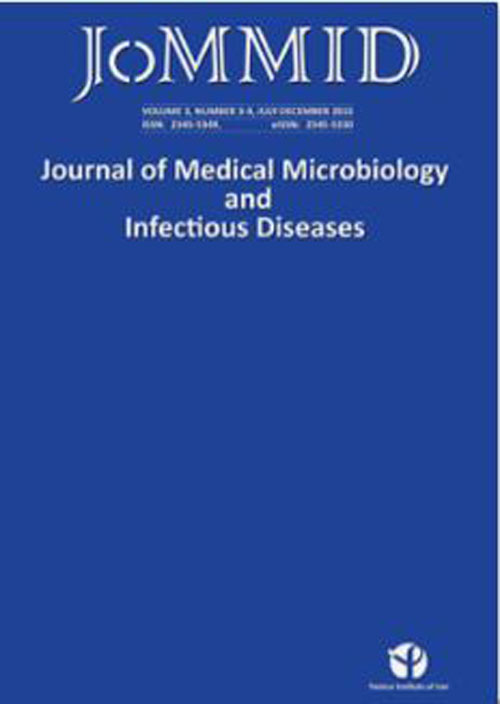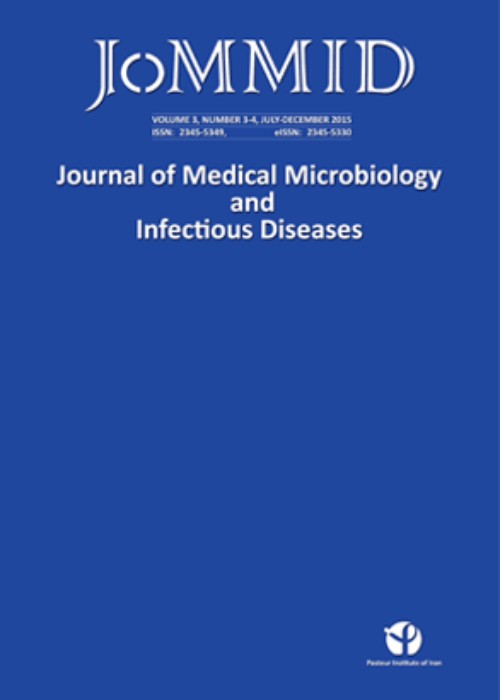فهرست مطالب

Journal of Medical Microbiology and Infectious Diseases
Volume:10 Issue: 3, Summer 2022
- تاریخ انتشار: 1401/07/26
- تعداد عناوین: 9
-
-
Pages 98-103Introduction
In recent years, the green synthesis of nanoparticles has received much attention. Green synthesis has several advantages over other
methodscost-effectiveness, simplicity, and non-toxicity. In the present study, we obtained the aqueous extract of Thymus daenensis (Celak) flora, biosynthesized the copper nanoparticles (Cu-NPs), and evaluated the antifungal activity.
MethodsUV-vis spectroscopy analyses, scanning electron microscopy (SEM), and energy-dispersive X-ray (EDX) were used to identify the synthesized nanoparticles. The antifungal activity of the synthesized copper nanoparticles was evaluated using the microdilution method.
ResultsAfter adding the extract to the copper sulfate solution, the solution color changed from light blue to yellowish-green. A maximum peak at the wavelength of 414 nm confirmed the copper nanoparticles formation. Scanning electron microscopy demonstrated the particle size ranging from 30 nm to 42 nm. The biosynthesized Cu-NPs had an inhibitory effect against Candida albicans, Fusarium solani, Aspergillus Niger, and Aspergillus flavus.
ConclusionOur findings demonstrated that T. daenensis aqueous extract acts as a reducer and stabilizer factor. We successfully synthesized Cu-NPs from copper sulfate using T. daenensis (Celak) flora aqueous extract according to the UV-Vis spectrum, FTIR, and SEM results. This research was the first report of Cu-NPs synthesized from an aqueous T. daenensis (Celak) flora extract. Our simple, quick, and inexpensive method for biosynthesis of a nanoparticle, which showed antifungal activity, provides a new potential antifungal agent for therapeutic applications.
Keywords: Antifungal activity, Aqueous extract, Green synthesis, Copper nanoparticles -
Pages 104-113Introduction
The increased frequency of Methicillin-resistant Staphylococcus aureus infections has led to renewed interest in the macrolide-lincosamide streptogramin B (MLS) group of antibiotics. Resistance to these antibiotics may be constitutive or inducible. Isolates resistant to erythromycin may show false in vitro susceptibility to clindamycin, leading to therapeutic failures. This study investigated the utility of the D-Test for detecting inducible clindamycin resistance in methicillin-resistant S. aureus isolates and determining the prevalence of various phenotypes in our region.
MethodsFor detecting inducible clindamycin resistance, a D-test using erythromycin and clindamycin as per CLSI guidelines was performed, and four different phenotypes were interpreted as methicillin-sensitive (MS) phenotype (D-test negative), inducible MLSB (iMLSB) phenotype (D-test positive), constitutive MLSB phenotype and sensitive to both.
ResultsOf the 987 isolates tested, 400 (40.53%) were MRSA. The prevalence of iMLSB, cMLSB phenotype, MS phenotype and sensitive phenotype in MRSA isolates was 42.5%, 10.5%, 28% and 19%, respectively. The iMLSB and cMLSB phenotypes were higher in males (24.75%, 6.25%) than females (P-value = 0.137). The majority of MRSA isolates originated from pus (83%). All S. aureus isolates showed 100% sensitivity to vancomycin and linezolid.
ConclusionThis study emphasizes the prevalence of inducible clindamycin resistance in MRSA in our setup. Incorporating the D-test into the routine Kirby–Bauer disk diffusion method in clinical microbiology laboratories will help clinicians make judicious use of clindamycin, minimizing treatment failure.
Keywords: MRSA, D-test, Constitutive clindamycin resistance, Inducible clindamycin resistance -
Pages 114-121Introduction
Proteus spp. are opportunistic members of Enterobacteriaceae, accounting for 10% of urinary tract infections and other primary clinical infections. They produce extended-spectrum beta-lactamases (ESBL) that can confer resistance to beta-lactam antibiotics. This study aimed to investigate the prevalence, antimicrobial susceptibility, molecular characteristics, and genetic relationship of ESBL-producing Proteus spp. clinical isolates in Babol, Northern Iran.
MethodsIn this cross-sectional study, out of 112 clinical samples, 30 Proteus spp. isolates were identified via specific biochemical assays. According to the Clinical and Laboratory Standards Institute (CLSI) guidelines, antibiotic susceptibility was evaluated using disc diffusion and agar dilution methods, and polymerase chain reaction (PCR) was used to detect blaTEM and blaSHV genes.
ResultsThe resistance rate to tetracycline and sulfamethoxazole was highest by disk diffusion and agar dilution. Multiple drug-resistant (MDR) isolates were 86% and 60% in disk diffusion and agar dilution assays. Seven (23.3%) isolates had the blaTEM genes and 18 (60%) blaSHV.
ConclusionESBL-producing Proteus spp. was highly prevalent, and the blaSHV was the most common resistance contributing gene. These findings and relatively high resistance to ampicillin demand more care in prescribing antibiotics. Also, the high prevalence of MDR isolates in patients infected with ESBL-producing Proteus spp. requires continuous surveillance.
Keywords: Proteus spp, Beta-lactamase, Multi-drug resistance, Antibiotic resistance -
Pages 122-128Introduction
Inflammatory bowel disease (IBD) is a group of chronic gastrointestinal disorders affecting millions worldwide. Several factors are involved in developing this disease, but gut microbiota is known to be one of the most critical factors. This study investigated the relationship between gut microbiota and IBD in a mouse model.
MethodsIn this study, two methods were used: chemical induction with dextran sulfate sodium (DSS) and biological induction with stool from a human with IBD (fecal microbiota transplantation) to induce inflammation in the gut of mice. The gut microbiota populations in both groups were studied using real-time PCR. In addition, the serum levels of inflammatory cytokines and the colon tissues of the mice were analyzed.
ResultsThe pathological results showed that the colon tissue in the FMT group had inflammatory changes as in the DSS group. The changes in the gut microbiota population in both FMT and DSS groups on the last day of the study also showed a similar pattern. Interleukin-1 and IL-6 also increased in the FMT and DSS groups compared to the control group.
ConclusionOur results showed a mutual relationship between gut microbiota and inflammatory diseases and that gut microbiota was not only the cause of IBD but may also be a consequence of this disease. In fact, by chemically inducing inflammation, the gut microbiota was altered. On the other hand, performing FMT from human stool with IBD altered the gut microbiota of mice and induced inflammatory disease in the mouse model.
Keywords: Inflammatory bowel disease, Gut microbiota, Fecal microbiota transplantation, Dextran sulfate sodium -
Pages 129-134Introduction
Nosocomial respiratory infections are a significant cause of mortality in hospitalized patients in Middle East countries. This study assesses the prevalence of nosocomial respiratory infection and associated factors as a tool for early diagnosis among intensive care unit (ICU) patients at risk for mortality.
MethodsFrom January to November 2021, 357 patients with more than 72 h hospitalization in ICU were monitored. Respiratory samples were examined for the presence of microbial isolates using clinical microbiology procedures based upon microscopic morphology, cultural and PCR methods. Demographic data were collected, including age, gender, date of hospitalization, underlying diseases, date of death, and laboratory data.
ResultsOut of fifty-three positive cultures, 18 samples (34%) were positive for fungal isolates, and the rest were positive for bacterial isolates. The most common bacterial and fungal isolates were Streptocossus Pyogenes (17.9%) and Candida albicans (22.5%). Of the infected patients, 67.9% were male, 39.62 % had kidney diseases, and 15.09% died due to nosocomial infections. The results also showed that the tumor necrosis factor α and complement component 3 levels were significantly associated with the incidence of respiratory fungal or bacterial infections (P<0.05).
ConclusionsThe rate of respiratory nosocomial infection in ICU patients was high. It is essential to implement control measures such as managing the length of hospital stay and examining the patient's immune factors to reduce the risk of these infections in ICU patients. Also, ICU patients should be prescribed appropriate antibiotics to prevent respiratory infections.
Keywords: Nosocomial Infection, Respiratory tract, Intensive care unit -
Pages 135-140Introduction
In Sub-Saharan Africa, the data on the mutations and variants of circulating SARS-CoV-2 is limited. This study aimed to screen specific mutations and variants of SARS-CoV-2 circulating in Burkina Faso.
MethodsThis study included symptomatic and asymptomatic individuals who underwent diagnostic testing for SARS-CoV-2 by RT-PCR on nasopharyngeal and oropharyngeal swabs from 7 December 2021 to 12 January 2022. Samples from individuals with a Ct value ≤ 33 were selected for the variants-specific mutation screening. The screening was performed using two kits, “SNPsig® SARS-COV-2 (Escape PLEX)" and "SNPsig® VariPLEX™ (COVID-19) Real-Time PCR Assay".
ResultsSARS-CoV-2 prevalence was 18.9% (332/1758). A total of 113 samples (34.04%) had a Ct value less than (≤ 33), with only 20.35% (23/113) belonging to symptomatic patients. The mean age was 39.01±13 years. The Beta variant (B.1.351) was the most detected one comprising 78.8% (89/113) of variants. Gamma and Delta variants were detected at a low proportion of 0.9% (1/113). No mutation or variant was detected in seven (6.2%) samples.
ConclusionSpecific mutation screening detected Beta (B.1.351), Gamma (P.1), and Delta (B.1.617.2) variants of SARS-CoV-2 circulating in Burkina Faso. The absence of mutations in some samples might suggest variants other than those detected.
Keywords: SARS-CoV-2, RT-PCR, Ct, Variant, Mutation, Burkina Faso -
Pages 141-145
Precision tracking and monitoring viral genome mutations are critical during a viral pandemic such as COVID-19. As molecular assays for diagnosing numerous infectious agents are being developed, RT-PCR is still deployed as the gold standard for detecting SARS-CoV-2. Despite its proofreading capability, SARS-CoV-2, like other RNA viruses, adopts several changes in its genome. If these mutations, especially deletions, occur in the target areas of primers and probes, they will hinder molecular detection methods from identifying the given gene. The authors describe the cases in which, despite the lack of the N gene detection, the ORF1ab gene was discovered with a relatively low cycle of threshold (Ct). Following sequencing, changes were discovered in the annealing region of the forward and reverse primers and probes used in the SARS-CoV-2 detection kit. Among the most significant mutations is a large deletion of 15 nucleotides in the N gene, which has never been seen in prior variants. This highlights the importance of persistent monitoring of hypervariable regions in the SARS-CoV-2 genome through sequencing and updating the molecular detection kits during the COVID-19 pandemic.
Keywords: SARS-CoV-2, COVID-19, N-gene target failure, RT-PCR, Variant -
Pages 146-148
What has happened in the world since the pandemic began? More than two years after the COVID-19 pandemic outbreak, the status of the disease is still unclear to us. Up to August 1, 2022, the disease has killed about 6.4 million people worldwide, although the actual death toll is estimated to be three times more than the official death toll [1]. During this time, safe vaccines with high efficacy against the virus have been developed, methods of viral transmission and pathogenicity are better understood, and more effective treatments have been proposed that have helped better control the disease over time. A significant percentage of the world's population has acquired the infection at least once, more than 65% of the world's population has received at least one dose of a COVID-19 vaccine, and about 25% have received at least one booster dose of the COVID-19 vaccine. More than 12 billion doses have been administered globally, with 5.5 million added daily. However, the vaccine distribution is inequitable, and in low-income countries, only about 20% of people have received at least one dose of the vaccine [2].
Keywords: COVID-19 pandemic, Outbreak, Variants, Leaky vaccines, Disease end, (re)emerging disease -
Pages 149-152
Malaria is an imported disease in non-endemic regions of Iran. Imported malaria cases to Iran mostly come from illegal immigrants from neighboring eastern countries. The present study describes a case of imported malaria in a 14-month-old Afghan boy with prolonged fever, vomiting, and diarrhea. He was referred and hospitalized in Shahid Beheshti, Kashan, central Iran, in December 2021. He and his parents traveled and immigrated to Kashan, Iran, three weeks before hospitalization. After staining with Giemsa stain, a thin blood smear test showed Plasmodium vivax with the Schüffner's dots in red blood cells. The patient was treated with an antimalarial drug and discharged from the hospital with normal vital signs. Before arriving in Iran, all immigrants should receive a screening test or be checked for malaria symptoms.
Keywords: Malaria, Plasmodium, Imported, Kashan, Children


